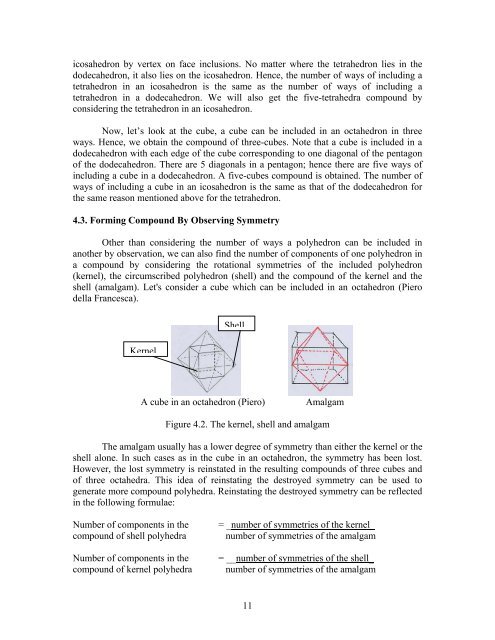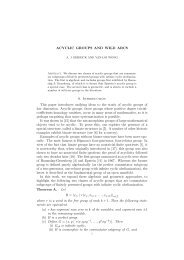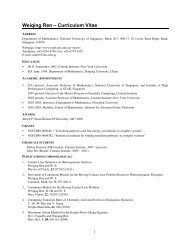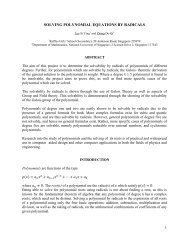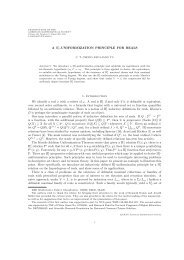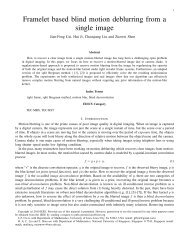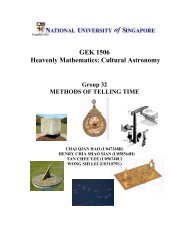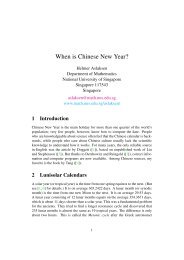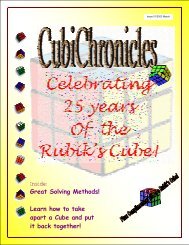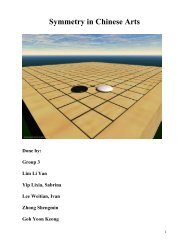Polyhedra - Department of Mathematics
Polyhedra - Department of Mathematics
Polyhedra - Department of Mathematics
Create successful ePaper yourself
Turn your PDF publications into a flip-book with our unique Google optimized e-Paper software.
icosahedron by vertex on face inclusions. No matter where the tetrahedron lies in the<br />
dodecahedron, it also lies on the icosahedron. Hence, the number <strong>of</strong> ways <strong>of</strong> including a<br />
tetrahedron in an icosahedron is the same as the number <strong>of</strong> ways <strong>of</strong> including a<br />
tetrahedron in a dodecahedron. We will also get the five-tetrahedra compound by<br />
considering the tetrahedron in an icosahedron.<br />
Now, let’s look at the cube, a cube can be included in an octahedron in three<br />
ways. Hence, we obtain the compound <strong>of</strong> three-cubes. Note that a cube is included in a<br />
dodecahedron with each edge <strong>of</strong> the cube corresponding to one diagonal <strong>of</strong> the pentagon<br />
<strong>of</strong> the dodecahedron. There are 5 diagonals in a pentagon; hence there are five ways <strong>of</strong><br />
including a cube in a dodecahedron. A five-cubes compound is obtained. The number <strong>of</strong><br />
ways <strong>of</strong> including a cube in an icosahedron is the same as that <strong>of</strong> the dodecahedron for<br />
the same reason mentioned above for the tetrahedron.<br />
4.3. Forming Compound By Observing Symmetry<br />
Other than considering the number <strong>of</strong> ways a polyhedron can be included in<br />
another by observation, we can also find the number <strong>of</strong> components <strong>of</strong> one polyhedron in<br />
a compound by considering the rotational symmetries <strong>of</strong> the included polyhedron<br />
(kernel), the circumscribed polyhedron (shell) and the compound <strong>of</strong> the kernel and the<br />
shell (amalgam). Let's consider a cube which can be included in an octahedron (Piero<br />
della Francesca).<br />
Kernel<br />
Shell<br />
A cube in an octahedron (Piero) Amalgam<br />
Figure 4.2. The kernel, shell and amalgam<br />
The amalgam usually has a lower degree <strong>of</strong> symmetry than either the kernel or the<br />
shell alone. In such cases as in the cube in an octahedron, the symmetry has been lost.<br />
However, the lost symmetry is reinstated in the resulting compounds <strong>of</strong> three cubes and<br />
<strong>of</strong> three octahedra. This idea <strong>of</strong> reinstating the destroyed symmetry can be used to<br />
generate more compound polyhedra. Reinstating the destroyed symmetry can be reflected<br />
in the following formulae:<br />
Number <strong>of</strong> components in the = _number <strong>of</strong> symmetries <strong>of</strong> the kernel_<br />
compound <strong>of</strong> shell polyhedra number <strong>of</strong> symmetries <strong>of</strong> the amalgam<br />
Number <strong>of</strong> components in the = __number <strong>of</strong> symmetries <strong>of</strong> the shell_<br />
compound <strong>of</strong> kernel polyhedra number <strong>of</strong> symmetries <strong>of</strong> the amalgam<br />
11


